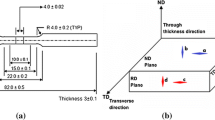Abstract
Microstructures of α precipitation from a deformed β matrix by thermomechanical processing were studied in a representative β titanium alloy, i.e. Ti-15V-3Cr-3Sn-3Al alloy. In the aged specimens, after solution treatment, the grain boundary is the most preferential nucleation site in the a precipitation. Localized slip occurs in the β matrix by cold rolling after solution treatment whereas (332)<113> deformation twins are formed by subzero rolling at 77 K. After subsequent aging of the rolled specimens, the α phase preferentially forms on those defects in the β matrix with a low energy orientation relationship (Burgers relationship). There is strong variant restriction in heterogeneous nucleation on such defects. Controlled short time annealing above the β transus (β recovery treatment) after cold rolling produces the fine β subgrain. By subsequent aging, α precipitates form preferentially on β subgrain boundaries and also within β subgrains. A great number of α variants are observed locally in the recovered and aged specimens than those in the cold rolled and aged specimens. β recovery treatment prior to aging improves the strength-ductility balance mostly because of the increase of local elongation.
Similar content being viewed by others
References
M. Okada and T. Nishikawa,J. Jpn. Inst. Metals 50, 555 (1986).
Y. Kawabe and S. Muneki,ISIJ Int. 31, 785 (1991).
M. Niinomi and T. Kobayashi,ISIJ Int. 31, 856 (1991).
T. Furuhara, H. Nakamori and T. Maki,Mater. Trans. JIM 33, 585 (1992).
T. Furuhara, S. Takagi, H. Watanabe and T. Maki,Metall. Mater. Trans. A 27, 1630 (1996).
T. Makino, R. Chikaizumi, T. Nagaoka, T. Furuhara and T. Maki,Mater. Sci. Eng. A 213, 51 (1996).
T. Maki, T. Nagaoka and T. Furuhara,Proc. Int. Symp. on Designing, Processing and Properties of Advanced Engineering Materials (ISAEM-97), p. 189, JSPS (1997).
T. Furuhara, T. Nagaoka and T. Maki,Non-Aerospace Applications of Titanium (eds., F H. Froes, P. G. Allen and M. Niinomi), p. 45, TMS (1998).
C. Ouchi, H. Suenaga and Y. Kohsaka,Proc. 6th World Conf. on Titanium (eds., P. Lacombe, R. Tricot and G. Beranger), p. 819, Les Editions de Physique, Paris (1989).
M. Okada,ISIJ Int. 31, 834 (1991).
Author information
Authors and Affiliations
Rights and permissions
About this article
Cite this article
Furuhara, T. Role of defects on microstructure development of beta titanium alloys. Metals and Materials 6, 221–224 (2000). https://doi.org/10.1007/BF03028215
Issue Date:
DOI: https://doi.org/10.1007/BF03028215




